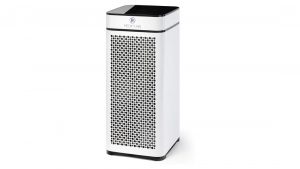
Air purifiers are used in home or office settings to clean the air by removing airborne contaminants. They are commonly used to improve indoor air quality by reducing second-hand smoke and eliminating allergens. Larger systems can be integrated with HVAC systems, but portable units, which are able to move from room-to-room, are more common.
- How Air Purifiers Work
- What Air Purifiers Remove from the Air
- Methods of Air Purification
- Frequently Asked Questions
In many ways air purifiers can be thought of as the residential and office equivalent of air scrubbers which are most often used for commercial use. In contrast, these units are more attractive, aren’t nearly as disruptive, and most importantly are far quieter than their commercial counterparts.
Bissell Air Purifiers – Levoit Air Purifiers – Medify Air Purifers
How do Air Purifiers Work?
Air purifiers work by drawing in air, passing it through a series of filters which remove allergens, particles, contaminants and even viruses from the air, and then returning it to the room or space it came from. In addition to a filter or series of filters, some units may also use electrochemical or absorption techniques in cleaning the air.
What Air Purifiers Remove from the Air
Air purifiers are used to remove a wide variety of contaminants and allergens including, but not limited to:
- Allergens
- Bacteria
- Dander
- Dust
- Gases
- Mold Spores
- Pollen
- Smoke Particles
- Viruses
- Volatile Organic Compounds
Most of the contaminants above can be removed by many of the units on the market today. There are others, however, that can only be removed by specific models. And, not all particulates are created equal. Level of filtration and advanced technologies dictate what a given air cleaner can remove from the air.
Tip: Shop by Use or Purpose
Simply searching for the term air purifier on Google shows how many different options there are on the market. With many different levels of air purification, types of filter media, active or passive technologies and manufacturer intent making choosing an air purifier time-consuming at best. The process is highly confusing at its worst.
We have compiled a few lists that feature the best air purifiers for specific purposes.
Methods of Air Purification
Not all purifiers go about cleaning the air in the same way. And, different methods have different applications.
Filtration
The most common method air purifiers use to clean air is filtration. Filtration leverages one or more filters which trap particles of a certain size, thus removing them from the air circulating in a given area.
Activated Carbon
While filters capture the smaller particles, activated carbon excels at absorbing volatile compounds. It does this at a molecular level, and activated carbon is often one filter among many or a coating on an air filter.
HEPA Filtration
Among filters, HEPA filters are likely the most widely known. Put into commercial use in the 1950s, HEPA stands for High Efficiency Particle Arrestance. For a filter to carry HEPA status in the United States, it must be capable of capturing 99.7% of all particles passing through it which have a 0.3 micron or larger diameter.
Years ago HEPA was a specific, trademarked technology, but has since become a general term used for any high efficiency filter.
PECO Filtration
Not nearly as common, PECO filtration captures very small particles using a process called photoelectrochemical oxidation. How small? Try 0.1 nanometers. Without getting in deep with the technical details, PECO filtration can destroy bacteria, mold, organic matter, viruses, and VOCs.
PECO filtration is only used in a few select, high-end air purifiers.
Air Purifier Manufacturers
The number of manufacturers making air purifiers has exploded in the 2000s. While this makes an incredibly large number of choices, we only review and recommend units made by long-standing, reputable companies. View our list of air purifier manufacturers worth consideration.
Common Questions About Air Purifiers
Yes. A high quality air purifiers will remove particles from the air, improving the overall air quality in the space it is being used. However, none can completely remove all of the allergens, particles, contaminants from a given area as many are not airborne, but at rest on a surface.
Generally speaking, an air purifier should be placed so walls, furniture or other objects can’t block its air intake or exhaust. It’s also important to note that the air intake may be at the base or bottom of the unit. The best advice is to refer to the manual that comes with the air purifier you own.
Prices vary for good quality air purifiers. Cost varies by type of filtration, how large of an area the air purifier can treat, and the and overall quality of the unit. Good quality units can be had for $100 or less, whereas the highest quality, most effective ones cost several hundred dollars to a thousand dollars or more.
